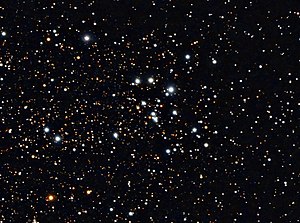astro.wikisort.org - Galaxy
Messier 18 or M18, also designated NGC 6613, is an open cluster of stars in the constellation Sagittarius. It was discovered by Charles Messier in 1764 and included in his list of comet-like objects.[8] From the perspective of Earth, M18 is situated between the Omega Nebula (M17) and the Small Sagittarius Star Cloud (M24).[3]
| Messier 18 | |
|---|---|
 Open cluster Messier 18 in Sagittarius | |
| Observation data (J2000.0 epoch) | |
| Right ascension | 18h 19m 58.0s[1] |
| Declination | –17° 06′ 06″[1] |
| Distance | 4.23 kly (1.296 kpc)[2] |
| Apparent magnitude (V) | 7.5[3] |
| Apparent dimensions (V) | 9.8′[4] |
| Physical characteristics | |
| Mass | 186+161 −86[5] M☉ |
| Radius | 26.2 light-years[5] |
| Estimated age | 33×106 years[6] |
| Other designations | Messier 18, NGC 6613, Cr 376, OCl 40[7] |
This is a sparse[9] cluster with a linear diameter of 8.04 pc,[5] a tidal radius of 7.3 pc,[6] and is centrally concentrated with core radius of 0.012 pc.[10] It has a Trumpler class of II 3 p.[4] The cluster is 33[6] million years old with an estimated mass of 188 M☉.[5] It has one definite Be star and 29 B-type stars in total.[9] There are three supergiant stars, all of class A or earlier.[11] The brightest component (lucida), designated HD 168352, is a B-type giant star with a class of B2 III and a visual magnitude of 8.65.[4]
Messier 18 is 1,296 pc[2] from the Earth and 6,830 pc from the Galactic Center.[5] It is orbiting the Milky Way core with a period of 186.5 million years and an eccentricity of 0.02. This carries it to as close as 6.5 kpc to, and as far as 6.8 kpc from the galactic core. It passes vertically through the galactic plane once every 27.4 million years, ranging no more than 80 pc above or below.[1]
As of January 2022, Messier 18 is one of the few remaining objects within the Messier Catalog to not have been photographed by the Hubble Space Telescope. [12]
Gallery
- M18 photo from the 2MASS project
 Map showing location of M18 (Roberto Mura)
Map showing location of M18 (Roberto Mura)
See also
- List of Messier objects
References
- Wu, Zhen-Yu; et al. (November 2009), "The orbits of open clusters in the Galaxy", Monthly Notices of the Royal Astronomical Society, 399 (4): 2146–2164, arXiv:0909.3737, Bibcode:2009MNRAS.399.2146W, doi:10.1111/j.1365-2966.2009.15416.x, S2CID 6066790.
- Kharchenko, N. V.; et al. (2005), "Astrophysical parameters of Galactic open clusters", Astronomy and Astrophysics, 438 (3): 1163–1173, arXiv:astro-ph/0501674, Bibcode:2005A&A...438.1163K, doi:10.1051/0004-6361:20042523, S2CID 9079873.
- Frommert, Hartmut; Kronberg, Christine (August 21, 2007), Messier 18, Students for the Exploration and Development of Space (SEDS), retrieved 2018-11-11.
- Lindoff, U. (December 1971), "The open clusters NGC 6613 (M 18) and NGC 6716", Astronomy and Astrophysics, 15: 439–449, Bibcode:1971A&A....15..439L.
- Joshi, Y. C.; et al. (October 2016), "Study of open clusters within 1.8 kpc and understanding the Galactic structure", Astronomy & Astrophysics, 593: 13, arXiv:1606.06425, Bibcode:2016A&A...593A.116J, doi:10.1051/0004-6361/201628944, S2CID 118610932, A116.
- Piskunov, A. E.; et al. (January 2008), "Tidal radii and masses of open clusters", Astronomy and Astrophysics, 477 (1): 165–172, Bibcode:2008A&A...477..165P, doi:10.1051/0004-6361:20078525.
- "M 18". SIMBAD. Centre de données astronomiques de Strasbourg. Retrieved November 11, 2018.
- Adam, Len (2018), Imaging the Messier Objects Remotely from Your Laptop, The Patrick Moore Practical Astronomy Series, Springer, pp. 117–120, Bibcode:2018imor.book.....A, ISBN 978-3319653853.
- McSwain, M. Virginia; Gies, Douglas R. (November 2005), "The Evolutionary Status of Be Stars: Results from a Photometric Study of Southern Open Clusters", The Astrophysical Journal Supplement Series, 161 (1): 118–146, arXiv:astro-ph/0505032, Bibcode:2005ApJS..161..118M, doi:10.1086/432757, S2CID 14498164.
- Santos-Silva, T.; Gregorio-Hetem, J. (November 6, 2012), "Characterisation of young stellar clusters", Astronomy & Astrophysics, 547: A107, arXiv:1209.1585, Bibcode:2012A&A...547A.107S, doi:10.1051/0004-6361/201219695, S2CID 119213441.
- Eggenberger, P.; et al. (May 2002), "The blue to red supergiant ratio in young clusters at various metallicities", Astronomy and Astrophysics, 386 (2): 576–582, arXiv:astro-ph/0202478, Bibcode:2002A&A...386..576E, doi:10.1051/0004-6361:20020262, S2CID 14373322.
- "Explore - the Night Sky | Hubble's Messier Catalog". 28 August 2017.
- "Stellar Lab in Sagittarius", www.eso.org, retrieved 11 August 2016.
External links
| Wikimedia Commons has media related to Messier 18. |
- Messier 18 on WikiSky: DSS2, SDSS, GALEX, IRAS, Hydrogen α, X-Ray, Astrophoto, Sky Map, Articles and images
На других языках
[de] Messier 18
Messier 18 (auch als NGC 6613 bezeichnet) ist ein etwa 7 mag heller offener Sternhaufen mit einer Winkelausdehnung von 10' im Sternbild Schütze. In ihm finden sich zahlreiche helle, blaue Riesensterne. Sie sind so heiß, dass sie überwiegend im blauen Licht und im nahen Ultravioletten leuchten. M 18 ist rund 4600 Lichtjahre von der Sonne entfernt. Anhand der massereichen blauen Sterne schätzen die Forscher, dass der Sternhaufen rund 30 Millionen Jahre alt ist.[3]- [en] Messier 18
[ru] M 18 (звёздное скопление)
Рассеянное скопление M 18 (также известное как M 18, NGC 6613 или Чёрный Лебедь) является рассеянным звёздным скоплением в созвездии Стрельца.Другой контент может иметь иную лицензию. Перед использованием материалов сайта WikiSort.org внимательно изучите правила лицензирования конкретных элементов наполнения сайта.
WikiSort.org - проект по пересортировке и дополнению контента Википедии


![Star cluster Messier 18 (upper left) and its surroundings, taken by the OmegaCAM.[13]](http://upload.wikimedia.org/wikipedia/commons/thumb/8/85/The_star_cluster_Messier_18_and_its_surroundings.jpg/120px-The_star_cluster_Messier_18_and_its_surroundings.jpg)
